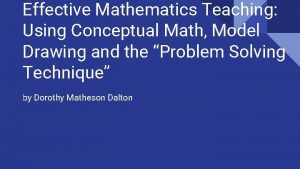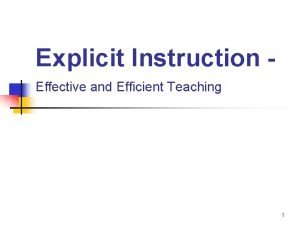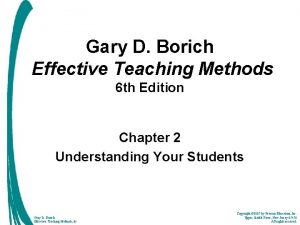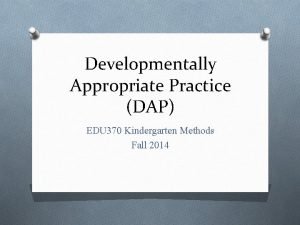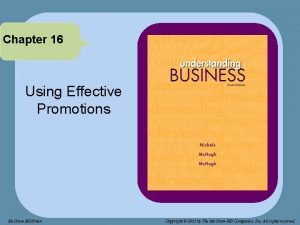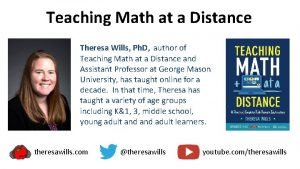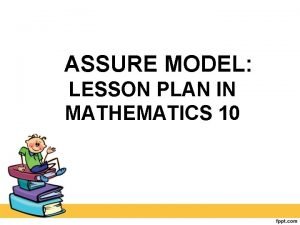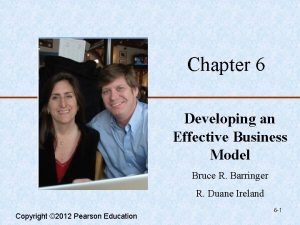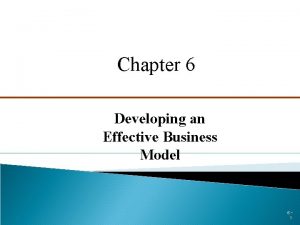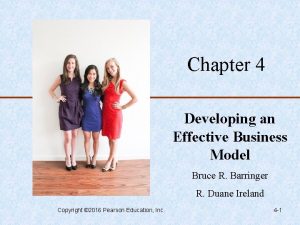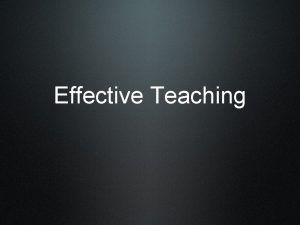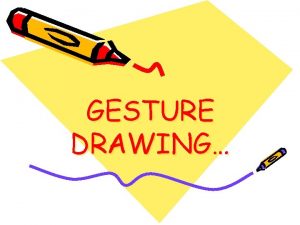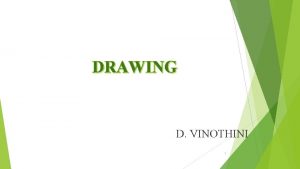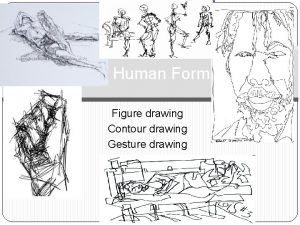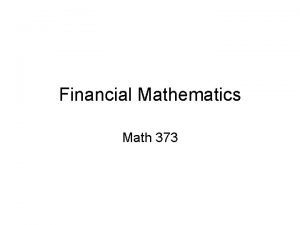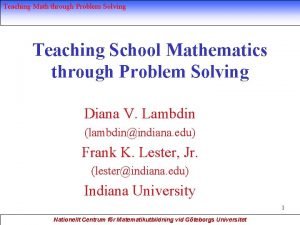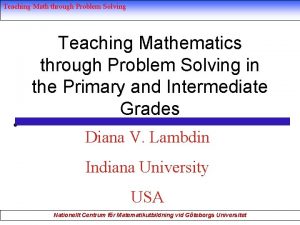Effective Mathematics Teaching Using Conceptual Math Model Drawing































- Slides: 31

Effective Mathematics Teaching: Using Conceptual Math, Model Drawing and the “Problem Solving Technique” by Dorothy Matheson Dalton

Solve the following problem: Tom has twice as many marbles as Luke. Together, they have 39 marbles. How many marbles does Tom have?

My original “Problem Solving Technique”

First Grade Assessment Task & Student Application of the PST

First Grade: Application of the PST

Second Grade Assessment Task

Second Grade: Application of the PST

Fourth Grade Motivational Math (Mentoring Minds) Question

Fourth Grade Motivational Math: Student Application of the PST

Fourth Grade Motivational Math: Application of PST

Fourth Grade Released North Carolina End-Of-Grade Test Question A store sold 336 DVD players last year. · The store sold 8 different brands of DVD players. · The store sold the same number of each brand of DVD players. How many of each brand of DVD players did the store sell?

Fourth Grade Released NCEOG: Application of the PST https: //www. youtube. com/watch? v=TXzb. ZJr. Hmys (Student Explanation)

“Tom” Problem: Solution Applying the PST https: //www. youtube. com/watch? v=23 w. Aj. BKRqec (Student Explanation)

Fourth Grade Released NC End of Grade Test Question: Application of the “Problem Solving Technique” Tom has twice as many marbles as Luke. Together, they have 39 marbles. How many marbles does Tom have? STEP 1: CHUNK! Only read the info. the author tells you, piece by piece. The student will only read part of the problem/sentence at a time; therefore, the student would stop reading after, “Tom has twice as many marbles as Luke”, as this is already important information. The student will then move on to Step 2, before reading any more of the problem.

Tom has twice as many marbles as Luke. Together, they have 39 marbles. How many marbles does Tom have? Step 2: MODEL, WRITE, and/or LABEL-who, what and/or how the author tells you. The student will label a T for Tom and an L for Luke, and he/she will draw a box for L, because he has some marbles, and two times as many boxes for T, because the author tells you T has twice as many marbles as L. Next, the student will go back to step 1 and read the next chunk.

Tom has twice as many marbles as Luke. Together, they have 39 marbles. How many marbles does Tom have? Step 1 (cont’d): CHUNK~The student will now read the next chunk/part of the problem, “Together, they have 39 marbles. ” Step 2 (cont’d): MODEL~The student will label a bracket around both T and L’s boxes to show that together, they both have 39 marbles. The student will label the bracket with the number 39 and the variable m for marbles. Step 1 (cont’d): CHUNK~The student will now read the remainder of the problem, “How many marbles does Tom have? ” Now we have a task to complete. On to Step 3.

Tom has twice as many marbles as Luke. Together, they have 39 marbles. How many marbles does Tom have? Step 3: RESTATE~Turn the author’s question into an answer sentence, leaving a blank for the answer. The student will now write, “Tom has _____ marbles. ” Also, the student MUST return to the model drawing. Here, the student will LABEL a QUESTION MARK next to what the author is asking for (beside Tom’s boxes).

Tom has twice as many marbles as Luke. Together, they have 39 marbles. How many marbles does Tom have? Step 4 -STRATEGY~Choose the appropriate strategy. Now, the student is able to use what the author of the problem has told him/her. The student is able to analyze the problem and decide that in order to find the number of marbles Tom has, he/she must divide the total of marbles Tom and Luke have altogether (this is information the author has already told us, AND it has already been labeled in the student’s model drawing). He/she must divide the 39 marbles into all of the boxes, which, according to what the author has told us and what the model drawing shows, would be 3 boxes.

Tom has twice as many marbles as Luke. Together, they have 39 marbles. How many marbles does Tom have? Step 5 -SOLVE!~The student solves the problem by dividing 39 by the 3. Step 6 -PROVE/DISPROVE~your answer is correct? Is it reasonable? The student is not done yet! He/she must now place the answer back in the answer sentence created in step 3, and now he/she must prove (or disprove) the answer. What generally happens is that the student will write down that Tom has 13 marbles; however, that would be inaccurate and unreasonable, as 13 would be the amount of marbles that LUKE has. 13 would go into EACH of the 3 boxes; therefore, Luke would have 13, and Tom would have twice as many as Luke. The student would then write a numerical equation: 13 x 2 = m. The student would then replace the variable with 26 and write 26 in the answer blank, as Tom had 26 marbles. The student can also prove the answer by showing 13 x 3 = 39, the original amount of marbles that Tom and Luke had together.

Now, your turn: (Fourth Grade Released NCEOG Question) Mrs. Harper ordered 3 different colors of markers. She ordered 25 of each marker. She also ordered some pencils. She ordered 3 times as many pencils as markers. How many pencils did Mrs. Harper order?

Markers and Pencils: Application of the PST

One more… (Fourth Grade Released NCEOG Question) Patrick is buying cheese for a party. He needs to buy 50 ounces of cheese. Cheese is only sold in 8 - and 12 -ounce packages. Which choice shows the least amount of cheese Patrick can buy for the party? A. Five 12 -ounce packages B. Two 12 -ounce packages and three 8 -ounce packages C. Seven 8 -ounce packages D. Three 12 -ounce packages and two 8 -ounce packages

Packages of Cheese: Application of the PST

Math Journal Rubric

Journal Entry Using the “Problem Solving Technique”

Examples of Division Using Model Drawings Division Model Advanced Division Model

Relation of Multiplication to Division Area Model of Division/Area Model of Multiplication/Model Drawing

Effective Mathematics Teaching Practices NCDPI:

Sample “I Can” Statement

Conceptual Math Videos Why is Math Different Now? https: //www. youtube. com/watch? v=u. OMK 6 tm. HUL 8&list=PLyu. M 67 Od. F-7 Slcyrqu. Po. X 2 Hz-xncl. I 5 am&index=1 Common Core Makes Me Mad https: //www. youtube. com/watch? v=q 0 aey. AN 0 Axo&list=PLyu. M 67 Od. F-7 Slcyrqu. Po. X 2 Hz-xncl. I 5 am&index=2 False Assumptions https: //www. youtube. com/watch? v=dmyb. O 35 F_EI&index=3&list=PLyu. M 67 Od. F-7 Slcyrqu. Po. X 2 Hz-xncl. I 5 am Conceptual Math for Parents and Students https: //docs. google. com/document/d/1 RRAYni. LOypw 1 Lh. DJ 2 S 25 k. J 4 qmb. Tm. F 7 Lp. IDIeq. TCq. Np. Y/edit? usp=sharingo

My Original Math Songs to Popular Tunes “Problem Solving Technique” Song to the tune of Go. Tye’s “Somebody That I Used to Know” https: //www. youtube. com/watch? v=95 Oc. Kp 7 DQCk Area Model of Division Song: “Watch Me (Split/Brace)” to the tune of Silento’s “Watch Me (Whip/Nae Nae) https: //www. youtube. com/watch? v=YA 5 kbe. Ut. NOM Area Model of Multiplication Song to the tune of One Republic’s “Counting Stars” https: //www. youtube. com/watch? v=c_ZRBXzl. K 0 I Rounding song to the tune of Maroon 5’s “Sugar” https: //www. youtube. com/watch? v=Ct. Ht 6 Lu. WRGA Measurement Song to the tune of Katy Perry’s “Roar” https: //www. youtube. com/watch? v=f. F 7 x. Yosyx 0 M Compare Fractions Song to the tune of Meghan Trainor’s “All About That Bass” https: //www. youtube. com/watch? v=Tqp 4 DW 526 Ic Let’s Simplify the Fraction to the tune of Daft Punk’s “Get Lucky” https: //www. youtube. com/watch? v=AQn-9 N-14 G 8
 Instructional aims
Instructional aims Disadvantages of inductive method of teaching mathematics
Disadvantages of inductive method of teaching mathematics Model drawing math
Model drawing math Effective teacher profile
Effective teacher profile Explicit instruction effective and efficient teaching
Explicit instruction effective and efficient teaching Gary borich
Gary borich 10 principles of effective online teaching
10 principles of effective online teaching Measures of effective teaching project
Measures of effective teaching project Dap kindergarten
Dap kindergarten Effective teaching evidence and practice
Effective teaching evidence and practice Using mathematics and computational thinking
Using mathematics and computational thinking Unary many to many
Unary many to many Phases of micro teaching
Phases of micro teaching Using effective promotions
Using effective promotions Teaching math at a distance
Teaching math at a distance Pedagogical approaches to teaching math
Pedagogical approaches to teaching math Spoon technical drawing
Spoon technical drawing Theoretical framework maker
Theoretical framework maker Topmarks
Topmarks Using assessment data for improving teaching practice
Using assessment data for improving teaching practice Presentation advantages and disadvantages
Presentation advantages and disadvantages Assure lesson plan sample
Assure lesson plan sample Assure model lesson plan example
Assure model lesson plan example Number is divisible by 11 using (vedic math)
Number is divisible by 11 using (vedic math) Production sheets food service
Production sheets food service Kitchen math workbook learning zone express answers
Kitchen math workbook learning zone express answers Math using letters
Math using letters 6 components of business model
6 components of business model Developing an effective business model
Developing an effective business model Barringer/ireland business model example
Barringer/ireland business model example Ostrow model of effective frequency
Ostrow model of effective frequency Using system.collections.generic
Using system.collections.generic


